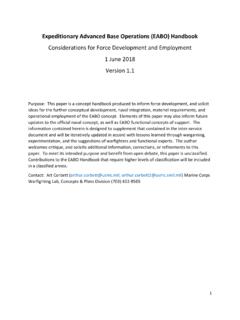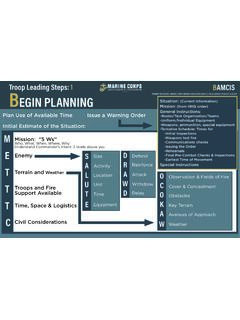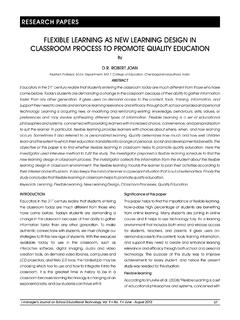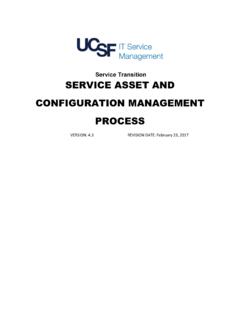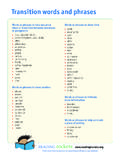Transcription of THE MARINE CORPS PLANNING PROCESS
1 THE MARINE CORPS PLANNING PROCESS STEP ONE: PROBLEM FRAMINGKEY INPUTSH igher Headquarters (HHQ)- Guidance & Intent- Mission Statement- WARNO*/OPORD*- Intelligence/IPB Products- Confirmation BriefsSituational InformationCommander and Staff- Experience- Expertise- JudgmentKEY RESULTSG raphic & narrative describing the current and desired stateBroad Operational ApproachInitial estimates of supportability (MSC)Initial staff estimates (Staff)Approved Mission StatementCommander s IntentCourse of Action (COA) Development guidanceDESIGN- Describe the Current and Desired States- Define the Problem Set- Develop the Broad Operational ApproachSTAFF ACTIONS- Task Analysis- Center of Gravity Analysis- Relative Combat Power Analysis- Assumption/Limitations- CCIRs*/RFIs*- Draft Mission Statement- Resource Shortfalls- Estimates (Staff & MSC*)- Update IPB products- Red Cell/Green Cell/Red Team *WARNO: Warning OrderOPORD: Operations OrderCCIR: Commander s Critical Information RequirementsRFI: Requests for InformationMSC: Major Subordinate Command Problem FramingPurpose.
2 To gain an understanding of the environment and the nature of the problem is to achieve understanding through critical thinking and dialogue1. Commander s Orientation2. Describe the current and desired states of the operating environment3. Define the problem set-As they exist within the environment-Preventing the environment from progressing toward the desired stateSTAFF ACTIONSC oncurrent and Complementary1. Analyze Tasks-Specified: Anything specified (OPORD*, Mission Statement, verbal, etc)-Implied: Necessary to accomplish a specified task-Essential: Specified or implied tasks that MUST be performed to accomplish mission2. Analyze Center of Gravity-Enemy and friendly (COG*, CC*, CR*, CV*)3.
3 Develop Assumptions-Logical-Realistic-Essential for PLANNING -Doesn t assume away an adversary capability4. Determine Limitations-Restraints: what can t be done-Constraints: something you must doPRESENT PROBLEM FRAMING BRIEFCOMMANDER S COURSE OF ACTION GUIDANCEISSUE WARNO- Input and Synthesis of both design and staff actions- Graphic and Narrative- Commander s initial intent and guidance5. Develop Mission Statement-Who, What, Where, When, Why- Must address the problem set6. Propose Initial CCIRs - PLANNING CCIRs-Operational CCIRs7. Perform Ongoing Activities-IPB* product refinement-Red Cell activities/Green Cell activities-Refinement of staff estimates and estimates of supportability-Battlespace refinement-Resource shortfalls identification-Commander s Critical InformationRequirement review/update-Requests for informationBroad Operational Approach4.
4 Develop the Broad Operational Approach*COG: Center of GravityCC: Critical CapabilitiesCR: Critical RequirementsCV: Critical Vulnerabilities IPB: Intelligence preparation on the BattlespaceTHE MARINE CORPS PLANNING PROCESS STEP TWO: Course of Action DevelopmentKEY INPUTSD esign & Staff Actions Operational ApproachApproved Mission StatementCommander s IntentCommander s COA Development Guidance KEY RESULTSCOA graphic & narrativeRefined IPB & intelligence productsPlanning support tools -DST*/DSM*/Synch MatrixEstimates of Supportability Staff estimatesCommander s Wargaming Guidance and Evaluation CriteriaUpdated WARNOA ctivitiesEstablish battlespace frameworkArray forces (friendly, adversary, population)
5 Assign purpose and then tasks for each subordinate elementTask organizeSequencing of actions to achieve the missionDivide operation into phasesIntegrate activities across time and spaceEstablish control measuresPresent COA Development brief to Commander*DST: Decision Support TemplateDSM: Decision Support MatrixCOA DEVELOPMENTP urpose: Develop one or more options for accomplishing the mission in accordance with the commander s operational approachActivities 1. Establish Battlespace Framework- Organize the battlespace Spatial/functional Deep, close, rear Decisive, shaping, sustaining-Organize the force Main effort, supporting effort, reserve, security2. Array Initial Forces-Determine RCPA* required to accomplish task -Array forces starting with decisive operations and continuing with shaping and sustaining operations3.
6 Assign Purpose and Then Tasks-What is necessary to accomplish mission?4. Convert Generic Units to Specific Units5. Task Organize-Structure and resource the force to conduct operations- Establish command and support relationships6. Sequencing -Arrangement of actions to achieve the mission7. Phasing-Divide operations into phases8. Develop COA Narrative and Graphic and Synch Matrix9. Determine Control Measures10. Rough Cut COA Brief-Rough Task Organization-Rough COA Graphic & Narrative11. COA Refinement-Develop supporting concepts13. Commander s Wargaming Guidance Evaluation Criteria 12. Conduct COA Development COA Criteria1. Feasible: Accomplishes mission with the available time, space, and resources2.
7 Acceptable: Worth the cost3. Suitable: Accomplishes the task and purpose4. Distinguishable: COAs differ from each other5. Complete: Address all the tasksOperational Approach-Commander s Intent-Commander s COA Guidance Types of Operations Forms of Maneuver COG Analysis Battlespace Framework Influence & Deception Activities Risk Guidance *RCPA: Relative Combat Power AnalysisTHE MARINE CORPS PLANNING PROCESS STEP THREE: Course of Action War GameKEY INPUTSCOA graphic & narrativePlanning support toolsEstimates of supportability Staff estimatesCommander s wargaming guidance & evaluation criteriaKEY RESULTSI dentified branches & sequelsRefined IPB & intelligence productsRefined staff estimatesRefined estimates of supportability Approved COAs for comparison and decisionComparison criteria/guidanceActivitiesAssign War Game billetsCollect documents & toolsSelect War Game technique Conduct COA War GameRecord COA War Game resultsRefine staff estimates, estimates of supportability, & supporting conceptsPresent War Game briefCOA War GamesActivities 1.
8 Organize for Wargaming 4. Conduct a War Game-Roll call -Orientation to the War Game board-Commander s War Game guidance-Confirm task organization two levels down-Review CCIRs and assumptions-Review critical events to be war gamed-Identify war game method to be utilized -Red/Green cells brief their COAs to be war gamed-Review rules of War Game-Execution of turnsAction Describe operations to all friendly units Describe the mission/tasks Describe the desired outcomeReaction Describe operations of all friendly units Describe probable outcome of contactCivilian Reaction Describe actions of other actors in the OE*Counteraction Identify additional actions and resources required Modify COA as necessary 5.
9 Record and display War Game results-War Game worksheet-Synchronization Matrix6. Assess the War Game resultsWar Game Techniques Key Events or Sequence of Critical Tasks Avenue in Depth Belt BoxInputs Commander s Wargaming guidance Commander s evaluation criteria IPB products PLANNING support toolsPurpose1. Validate COAs by testing each COA against a thinking adversary2. Improve each COA3. Evaluate strengths & weaknesses of each COA4. Better understand problem and environment 2. Gather documents & tools3. Select a War Game techniqueTo Improve the Plan*OE: Operating EnvironmentTHE MARINE CORPS PLANNING PROCESS STEP FOUR: COA Comparison and DecisionKEY INPUTS Updated IPB products Updated, complete COAs COA war game worksheet COA evaluation worksheet Resource shortfalls Updated CCIRs Decision Support Template & Decision Support Matrix Branches & sequels identified for further planningKEY RESULTSA pproved COA Guidance for branches & sequelsUpdated WARNOA ctivitiesEvaluate COAs against Commander s Evaluation CriteriaCompare COAsCommander s Decision COA Comparison And DecisionPurposeFor the Commander to evaluate all friendly COAs against established criteria, then compare each COA against each other.
10 And decide which COA best accomplishes the Course of ActionThe separate evaluation of each COA against the Cmdr s Evaluation Criteria with special consideration to advantages, disadvantages, and Courses of Action to each otherThe comparison of each COA to each other using the advantages, disadvantages, and risks developed in the evaluation s DecisionUpdate the Warning OrderRefine the Concept of Operations12345 The Commander selects the COA that best accomplishes the mission. There are four options: Select Modify New DiscardThe concept of operations is a general description of actions to be taken and a generic organization for combat that serves as the basis for supporting concepts, functional or detailed PLANNING , and branch and Sequel Warning Order allows subordinates to continue concurrent Evaluation Criteria-Principles of war-Limitation of casualties-Exploitation of the adversary s weaknesses/friendly strengths-Population considerations-Opportunity for maneuver-Concentration on combat power-Speed-Supportability-Political considerations-Force protection-Risk assessmentTHE MARINE CORPS PLANNING PROCESS STEP FIVE.

